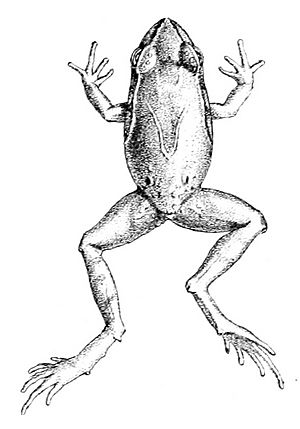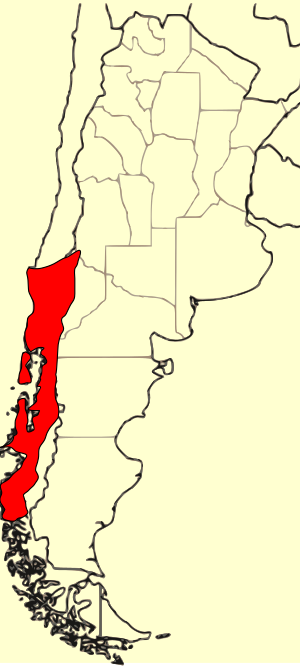Eupsophus calcaratus facts for kids
Quick facts for kids Eupsophus calcaratus |
|
|---|---|
 |
|
| Conservation status | |
| Scientific classification | |
 |
|
| Synonyms | |
|
Cacotus calcaratus Günther, 1881 |
The Chiloe Island ground frog (Eupsophus calcaratus) is a type of frog that belongs to the Alsodidae family. This special frog lives only in Patagonia, a region in southern Argentina and Chile. It is found across a very wide area compared to other frogs in Chile.
Contents
About the Chiloe Island Ground Frog
What Does It Look Like?
The Chiloe Island ground frog is a medium-sized frog. It usually measures about 31 to 36 millimeters (around 1.2 to 1.4 inches) from its snout to its rear end. Its head is wider than it is long, and its snout (nose area) is rounded.
The frog's skin is a bit bumpy but has many spots. It also has a pattern that looks like a net. The colors of these frogs can be very different from one frog to another. However, they often have a special hourglass shape on their head.
Life Cycle and Reproduction
The baby frogs, called tadpoles, grow in small holes in the ground that are filled with water. Male frogs of this species are very caring parents. They stay with their eggs and tadpoles to protect them. These tadpoles are "endotrophic," which means they get all the food they need from the egg yolk and do not need to eat anything else while they are growing.
Where It Lives and How We Protect It
Habitat and Environment
The Chiloe Island ground frog lives in wet Nothofagus temperate forests. These are cool, moist forests found in certain parts of the world. The frogs prefer shady spots, like swamps or the edges of streams.
Conservation Status
This frog is common in places where its habitat is suitable. However, its home is at risk. Losing its habitat due to deforestation (when forests are cut down) is a big problem. Also, water pollution from forestry work can harm these frogs.
See also
- In Spanish: Rana de hojarasca austral para niños


